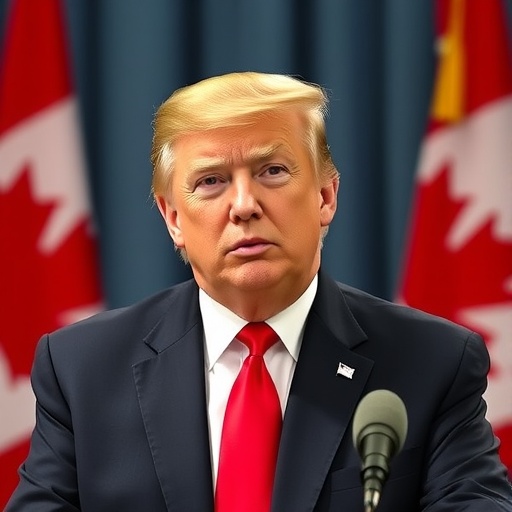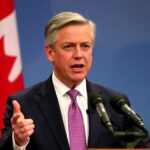Trump Escalates Trade War with Canada Tariffs Threat Over Controversial Ontario Anti-Tariff Ad, Clouds ASEAN Summit Meeting with Mark Carney
In a bold move that’s sending shockwaves through North American markets, President Donald Trump has threatened to impose steep new tariffs on Canadian imports, directly in response to a provocative anti-tariff television advertisement produced by the Ontario government. The ad, which aired nationwide in the United States last week, criticized U.S. trade policies and urged American consumers to support Canadian products amid ongoing disputes. This escalation comes at a precarious time, casting serious doubt on a planned bilateral meeting between Trump and Canadian Prime Minister Mark Carney at the upcoming ASEAN Summit.
The announcement, delivered via Trump’s signature Twitter post on Monday morning, has reignited fears of a full-blown trade war between the two longtime allies. “Canada’s sneaky ad campaign is an attack on American workers—time for tariffs to make them pay!” Trump wrote, vowing to slap 25% duties on key exports like lumber, automobiles, and dairy products. Economists warn that such measures could cost U.S. consumers billions and disrupt supply chains, while bolstering calls for renegotiation of the USMCA trade agreement.
As tensions mount, the global spotlight turns to the ASEAN Summit in Jakarta next month, where Trump and Carney were expected to hash out differences. Sources close to the White House indicate the meeting is now on shaky ground, with Canadian officials expressing frustration over what they call “unwarranted aggression.” This latest spat underscores the fragility of U.S.-Canada relations, which have been strained since Trump’s first term.
The Provocative Ontario Ad That Lit the Fuse
The controversy erupted when Ontario’s provincial government launched a $2 million ad campaign targeting U.S. audiences. Titled “Fair Trade for Fair Neighbors,” the 30-second spot featured everyday Canadians decrying what it described as “unfair U.S. tariffs that hurt families on both sides of the border.” Filmed against the backdrop of Toronto’s bustling streets and Ontario’s vast timberlands, the ad highlighted how American tariffs on Canadian softwood lumber have driven up housing costs in the U.S. by an estimated 10-15%, according to a recent study by the National Association of Home Builders.
Ontario Premier Doug Ford defended the ad as a necessary response to what he called “economic bullying from south of the border.” In a press conference Tuesday, Ford stated, “We’re not starting a fight; we’re standing up for our workers. If the U.S. wants to play hardball, Ontario won’t back down.” The ad’s timing was no accident—it coincided with rising U.S. inflation concerns, where lumber prices have surged 20% year-over-year due to supply shortages exacerbated by trade barriers.
Critics in the U.S., including Trump’s trade advisors, labeled the campaign as foreign interference in domestic politics. White House economic adviser Peter Navarro echoed this sentiment, telling Fox News, “This isn’t advertising; it’s propaganda designed to undermine American sovereignty. President Trump’s response is measured and protects our interests.” The ad has already garnered over 5 million views on social media, sparking a viral debate that has amplified calls for protectionist policies on both sides.
Trump’s Tariff Threats: A Blueprint for Escalation
President Donald Trump‘s threat of new Canada tariffs marks a significant escalation in what many fear could evolve into a broader trade war. Detailing his plans in a series of posts and a White House briefing, Trump specified targeting sectors vital to Canada’s economy, including a proposed 25% tariff on aluminum and steel—reviving levies that were partially lifted under the USMCA in 2019. He also mentioned automobiles, noting that Canadian vehicle exports to the U.S. totaled $50 billion last year, per U.S. Census Bureau data.
Trump justified the move by claiming the Ontario ad misrepresented U.S. policies and sought to sway American public opinion ahead of midterm elections. “Canada thinks they can run ads in our country without consequences? Wrong! Tariffs will bring jobs back home,” he declared during a rally in Michigan, a key auto-manufacturing state. This isn’t Trump’s first rodeo with Canada tariffs; during his first presidency, he imposed duties on Canadian goods, leading to retaliatory measures that cost U.S. farmers $1.4 billion in exports, according to the U.S. Department of Agriculture.
Market reactions were swift: The Canadian dollar dipped 1.2% against the U.S. dollar immediately following Trump’s announcement, while shares in U.S. automakers like Ford and General Motors fell 2-3%. Analysts from Goldman Sachs estimate that full implementation of these tariffs could add $300 to the price of a new car in the U.S., hitting consumers already grappling with post-pandemic inflation rates hovering at 3.5%.
Mark Carney’s Measured Pushback and Diplomatic Maneuvering
Canadian Prime Minister Mark Carney, a former Bank of England governor known for his steady hand in economic crises, responded with a blend of diplomacy and firmness. In a statement from Ottawa, Carney said, “Canada values our partnership with the United States, but we will not tolerate threats that undermine fair trade. This ad was about facts, not fiction, and we’re open to dialogue—but not under duress.” His words reflect a strategic approach, balancing domestic pressures from provinces like Ontario with the need to preserve U.S. relations.
Carney’s tenure has seen Canada navigate multiple U.S. trade frictions, including disputes over dairy quotas in the USMCA. Under his leadership, Canada has diversified exports, increasing ties with the EU and Asia by 15% since 2020, per Statistics Canada. Yet, the U.S. remains Canada’s largest trading partner, accounting for 75% of its exports worth over $400 billion annually. Carney has hinted at retaliatory tariffs on U.S. goods like whiskey and motorcycles if Trump’s threats materialize, a tactic that proved effective in 2018 when similar measures prompted quick negotiations.
Behind the scenes, Carney’s team is lobbying allies at the ASEAN Summit to mediate. “The summit provides a neutral ground to reset relations,” a senior Canadian official told Reuters anonymously. Carney’s economic credentials—having steered global finance through the 2008 crisis—position him as a credible voice, but Trump’s unpredictable style could complicate matters.
ASEAN Summit Under Shadow: Bilateral Meeting in Jeopardy
The ASEAN Summit, scheduled for early November in Jakarta, was poised to be a pivotal venue for U.S.-Canada reconciliation. Originally, Trump and Carney planned a sideline meeting to discuss supply chain resilience and climate trade initiatives, amid growing Indo-Pacific tensions. However, the tariff threats have thrown these plans into disarray, with U.S. officials privately signaling a possible cancellation.
ASEAN leaders, representing 10 Southeast Asian nations with a combined GDP of $3.6 trillion, have urged de-escalation. Indonesian President Joko Widodo, as summit host, tweeted, “Trade disputes between friends weaken us all. Let’s focus on cooperation.” The event’s agenda includes digital economy pacts, but the U.S.-Canada rift risks overshadowing these, potentially alienating smaller economies reliant on stable North American trade.
Diplomatic sources indicate Carney is pushing for a virtual alternative if in-person talks falter, while Trump has mused about attending solo to court ASEAN investments. The summit’s timing is critical: With U.S. midterms looming, Trump may use the platform to project strength, but failure to meet Carney could signal deeper alliance fractures. Past ASEAN gatherings have brokered deals, like the 2019 RCEP trade pact, offering hope—but experts say the current impasse demands unprecedented goodwill.
Economic Ripples and the Path to Resolution
Beyond the headlines, the threat of a renewed trade war with Canada tariffs poses profound economic challenges for both nations. U.S. businesses, particularly in the Midwest, rely on Canadian inputs; for instance, 30% of U.S. auto parts come from Canada, per the Alliance for American Manufacturing. Implementing new tariffs could shave 0.5% off U.S. GDP growth next year, according to projections from the Peterson Institute for International Economics, while Canada’s economy—already facing 2% inflation—might see unemployment rise by 1% in export-dependent sectors.
Environmental implications are equally stark: Tariffs could hinder joint efforts on clean energy, like the $10 billion Great Lakes restoration project. Consumer advocates warn of higher grocery prices, as Canadian dairy faces duties, potentially increasing U.S. milk costs by 5-7%. On the flip side, some U.S. manufacturers applaud Trump’s stance, arguing it levels the playing field against subsidized Canadian industries.
Looking ahead, resolution hinges on backchannel talks. The USMCA’s dispute resolution panel could intervene, but timelines stretch to 2025. With the ASEAN Summit as a potential turning point, stakeholders urge compromise: Ontario might pull the ad, while Trump could soften tariffs in exchange for concessions on digital taxes. As one trade expert from the Brookings Institution put it, “This isn’t just about an ad—it’s a test of whether North America can weather populist storms.” The coming weeks will reveal if dialogue prevails over division, shaping trade dynamics for years to come.










